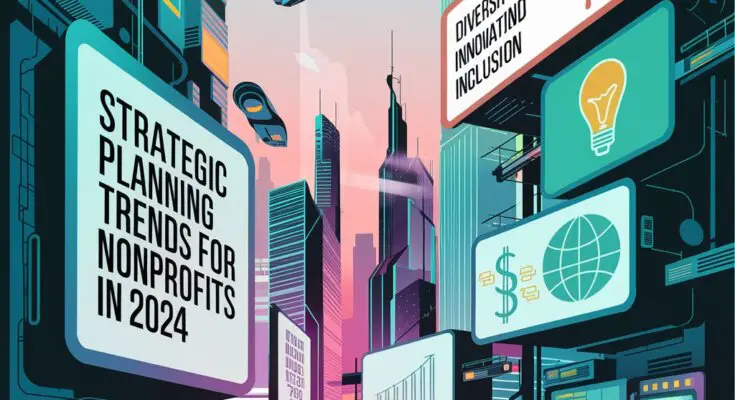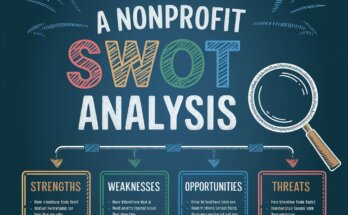In the ever-evolving landscape of nonprofit management, staying ahead requires a keen understanding of the latest strategic planning trends.
As we navigate through 2024, nonprofits face unique challenges and opportunities that demand innovative approaches to mission fulfillment and organizational growth.
Whether you’re a seasoned nonprofit leader or just starting out, understanding these trends is crucial for sustainable success.
Let’s dive into the key strategic planning trends shaping the nonprofit sector this year and explore how you can implement them effectively.
1. Embrace Digital Transformation
One of the most significant trends in 2024 is the ongoing digital transformation within nonprofits. Technology is no longer a luxury, but a necessity for efficient operations, effective communication, and broader reach.
From cloud-based solutions to data analytics, digital tools empower nonprofits to streamline processes, enhance donor engagement, and make data-driven decisions.
Practical Example: Imagine a nonprofit focused on environmental conservation. By adopting a customer relationship management (CRM) system, they can track donor interactions, analyze giving patterns, and personalize communication. This not only improves donor retention but also attracts new supporters by demonstrating transparency and impact through data.
2. Prioritize Diversity, Equity, and Inclusion (DEI)
In 2024, DEI remains a cornerstone of strategic planning for nonprofits. Emphasizing diversity, equity, and inclusion ensures that organizations are representative of the communities they serve and can address issues more comprehensively.
Practical Example: A nonprofit working in education might implement DEI training for staff and board members, ensuring that their programs are culturally sensitive and accessible to all students. This approach not only fosters a more inclusive environment but also broadens the organization’s impact by reaching a diverse population.
3. Leverage Data-Driven Decision Making
Data is the new currency in the nonprofit world. Data-driven decision making allows organizations to measure their impact accurately, identify areas for improvement, and demonstrate effectiveness to stakeholders.
Practical Example: A health-focused nonprofit could use data analytics to track the outcomes of their programs, such as the number of individuals served or improvements in health metrics. By analyzing this data, they can optimize their initiatives, secure funding by showcasing tangible results, and adjust strategies to better meet their goals.
4. Enhance Community Engagement
Building strong relationships with the community is essential for the success of any nonprofit. Community engagement goes beyond traditional fundraising; it involves active participation, collaboration, and fostering a sense of ownership among community members.
Practical Example: A nonprofit dedicated to homelessness prevention might host community forums and workshops, encouraging residents to share their experiences and solutions. By involving the community in decision-making processes, the organization can develop more effective programs and build a loyal support base.
5. Focus on Sustainability and Resilience
Sustainability and resilience have become critical focal points in strategic planning. Nonprofits must develop strategies that ensure long-term viability, especially in the face of economic uncertainties and global challenges.
Practical Example: A wildlife conservation nonprofit could diversify its funding sources by combining grants, individual donations, and earned income from eco-tourism. This diversification reduces dependency on a single revenue stream, making the organization more resilient to financial fluctuations.
6. Integrate Collaborative Partnerships
Collaboration is key to amplifying impact. Forming strategic partnerships with other organizations, businesses, and government agencies can enhance resources, expand reach, and foster innovation.
Practical Example: A nonprofit focused on mental health might partner with local schools, healthcare providers, and businesses to create a comprehensive support network. These partnerships can provide additional resources, share expertise, and create a unified approach to addressing mental health issues in the community.
7. Incorporate Adaptive Leadership
In a rapidly changing environment, adaptive leadership is essential. Leaders who can pivot, embrace change, and guide their organizations through uncertainty are invaluable in the nonprofit sector.
Practical Example: During the COVID-19 pandemic, many nonprofits had to shift their operations online. An adaptive leader would assess the new reality, implement virtual programming, and train staff to use digital tools effectively, ensuring that the organization continues to serve its mission despite challenges.
A Journey of Transformation
Let’s take a moment to share the story of GreenFuture, a nonprofit dedicated to promoting sustainable agriculture. In early 2024, GreenFuture faced declining donations and reduced volunteer participation. Their strategic planning team realized they needed to pivot to survive.
They embraced digital transformation by launching an online platform for virtual workshops and webinars, allowing them to reach a wider audience.
Recognizing the importance of DEI, they diversified their leadership team and tailored their programs to include underrepresented communities in agriculture. By leveraging data analytics, they identified key areas where their programs had the most impact and adjusted their strategies accordingly.
GreenFuture also focused on community engagement by organizing local events and collaborating with other environmental organizations.
They diversified their funding sources, securing grants, individual donations, and partnerships with eco-friendly businesses. Through adaptive leadership, the organization navigated challenges and emerged stronger, increasing their impact by 40% within a year.
GreenFuture’s journey highlights the power of strategic planning trends in transforming nonprofits. By embracing these trends, they not only survived but thrived, making a more significant difference in their community.
8. Strengthen Financial Planning and Management
Robust financial planning is a fundamental aspect of strategic planning. Nonprofits must ensure they have the financial resources to sustain their programs and operations while maintaining transparency and accountability to donors.
Practical Example: A nonprofit arts organization could implement a comprehensive budgeting process that includes forecasting revenue from various sources and monitoring expenses closely. By maintaining financial health, the organization can invest in new projects, respond to unexpected challenges, and build trust with stakeholders through transparent financial reporting.
9. Enhance Volunteer Management
Volunteers are the lifeblood of many nonprofits. Effective volunteer management strategies ensure that volunteers are engaged, motivated, and utilized efficiently to support the organization’s mission.
Practical Example: A community center could develop a volunteer training program that equips volunteers with the necessary skills and knowledge to perform their roles effectively. Additionally, implementing a recognition system, such as volunteer appreciation events or awards, can boost morale and retention, ensuring that the organization has a reliable and dedicated volunteer base.
10. Adopting Sustainable Practices
Sustainability is not just an environmental concern; it also encompasses financial and operational sustainability. Nonprofits need to adopt practices that ensure long-term viability and minimal negative impact on the environment.
Practical Example: An environmental nonprofit might adopt paperless office practices, reduce energy consumption, and implement recycling programs. These sustainable practices not only reduce operational costs but also align with the organization’s mission, demonstrating a commitment to environmental stewardship.
11. Utilize Impact Measurement Tools
Measuring and communicating impact is crucial for demonstrating the effectiveness of nonprofit programs. Impact measurement tools help organizations quantify their success and provide evidence to stakeholders.
Practical Example: A literacy nonprofit could use assessment tools to measure improvements in reading levels among participants. By collecting and analyzing this data, the organization can showcase their impact to donors, secure funding, and make informed decisions to enhance their programs.
12. Navigate Regulatory Changes
Staying compliant with changing regulations is essential for nonprofits. Keeping abreast of regulatory changes ensures that organizations operate within legal frameworks and avoid potential penalties.
Practical Example: A nonprofit providing healthcare services must stay updated on changes in healthcare laws and data privacy regulations. By implementing compliance training and regularly reviewing policies, the organization can ensure that they meet all legal requirements and protect the privacy of their clients.
13. Invest in Staff Development
A skilled and motivated team is vital for the success of any nonprofit. Investing in staff development ensures that employees are equipped with the knowledge and skills needed to drive the organization forward.
Practical Example: A nonprofit focused on youth development might offer professional development workshops for their staff, covering topics like grant writing, digital marketing, and program evaluation. By fostering a culture of continuous learning, the organization can enhance staff performance and job satisfaction, leading to better outcomes for their programs.
14. Adopt Flexible Programming
Flexibility in program design allows nonprofits to adapt to changing circumstances and meet the evolving needs of their communities. Flexible programming ensures that organizations can pivot quickly in response to new challenges and opportunities.
Practical Example: A disaster relief nonprofit could design their programs to be scalable and adaptable, allowing them to respond swiftly to different types of emergencies, whether natural disasters, pandemics, or humanitarian crises. This flexibility enables the organization to provide timely and effective assistance when it’s needed most.
The Turning Point for HopeBridge
HopeBridge, a nonprofit dedicated to providing mental health services, faced a critical juncture in mid-2024. With increasing demand for their services and limited resources, they needed a strategic overhaul to continue their mission effectively.
The leadership team decided to integrate several strategic planning trends. They invested in a new CRM system to better manage client information and donor relationships, enhancing their ability to provide personalized support and engage more effectively with their donor base.
Understanding the importance of DEI, HopeBridge diversified their staff to better reflect the communities they served, fostering a more inclusive environment.
HopeBridge also embraced data-driven decision making by implementing robust impact measurement tools to track client outcomes and program effectiveness. This data not only helped them refine their services but also made a compelling case for additional funding from grantmakers and donors.
By prioritizing community engagement, HopeBridge launched a series of virtual support groups and local outreach initiatives, expanding their reach and building stronger connections within the community. They diversified their funding streams, incorporating individual donations, corporate sponsorships, and government grants, which provided financial stability and resilience.
Through adaptive leadership, HopeBridge navigated their challenges, transforming into a more efficient, inclusive, and impactful organization. Their success story serves as an inspiring example of how embracing strategic planning trends can lead to profound positive change.
15. Promote Sustainability and Long-Term Impact
Focusing on sustainability ensures that nonprofits can continue their mission for years to come. Sustainability planning involves creating strategies that support long-term success and minimize dependency on fluctuating funding sources.
Practical Example: A nonprofit focused on clean water initiatives might invest in sustainable infrastructure projects, such as building wells with maintenance plans, rather than relying solely on short-term grants. By ensuring that their projects are self-sustaining, the organization can provide ongoing benefits to communities without constant external support.
16. Enhance Brand Identity and Storytelling
A strong brand identity and effective storytelling are powerful tools for nonprofits to communicate their mission, engage supporters, and differentiate themselves from others in the field.
Practical Example: A nonprofit working on animal rescue can develop a compelling brand story by sharing the journeys of rescued animals and the impact of their work on both animals and the community. By leveraging social media, videos, and personal testimonials, they can create an emotional connection with their audience, inspiring more people to support their cause.
17. Leveraging Artificial Intelligence (AI) and Automation
Artificial Intelligence and automation are transforming how nonprofits operate. These technologies can enhance efficiency, reduce costs, and provide deeper insights into program effectiveness and donor behavior.
Practical Example: A nonprofit organizing large-scale events can use AI-powered chatbots on their websites to answer frequently asked questions, handle registrations, and provide real-time updates. Automation tools can also manage repetitive tasks like sending thank-you emails to donors, freeing up staff time to focus on more strategic activities.
18. Building a Resilient Organizational Culture
A resilient organizational culture is essential for navigating challenges and maintaining momentum. Building resilience involves fostering a positive work environment, encouraging innovation, and supporting staff well-being.
Practical Example: A nonprofit dedicated to combating hunger can cultivate resilience by promoting a culture of collaboration, encouraging team members to share ideas, and providing resources for professional growth. By prioritizing staff well-being and fostering a supportive environment, the organization can better handle stress and adapt to changing circumstances.
19. Incorporate Sustainable Funding Models
Diversifying funding sources is key to financial stability. Sustainable funding models ensure that nonprofits have reliable income streams to support their programs and initiatives.
Practical Example: A nonprofit focused on arts education might combine individual donations, corporate sponsorships, government grants, and revenue from ticketed events. This diversification reduces reliance on a single funding source, providing financial security and the ability to invest in long-term projects.
20. Strengthen Governance and Leadership
Effective governance and strong leadership are fundamental to a nonprofit’s success. Good governance practices ensure accountability, transparency, and strategic direction.
Practical Example: A nonprofit providing community services could establish a diverse and active board of directors, implement regular board training sessions, and create clear governance policies. Strong leadership and governance practices help the organization stay aligned with its mission, make informed decisions, and maintain trust with stakeholders.
21. Implement Agile Methodologies
Adopting agile methodologies allows nonprofits to be more flexible and responsive to changes. Agile approaches emphasize iterative progress, collaboration, and adaptability.
Practical Example: A nonprofit working on technology education could use agile project management techniques to develop their curriculum. By breaking down the project into smaller, manageable tasks and regularly reviewing progress, they can quickly adjust to feedback and ensure that the curriculum remains relevant and effective.
22. Enhance Marketing and Communication Strategies
Effective marketing and communication are essential for raising awareness, attracting supporters, and driving engagement. Nonprofits need to develop strategies that effectively convey their mission and impact.
Practical Example: A nonprofit focused on wildlife conservation might create a comprehensive marketing plan that includes social media campaigns, email newsletters, and partnerships with influencers. By leveraging multiple channels, they can reach a broader audience, engage more supporters, and increase donations.
23. Leverage Blockchain Technology
Blockchain technology is emerging as a valuable tool for nonprofits, offering enhanced security, transparency, and efficiency in various operations.
Practical Example: A nonprofit working in financial transparency could use blockchain to track donations and ensure that funds are used as intended. This technology provides a transparent ledger that donors can access, increasing trust and accountability.
Take Action Today!
As we’ve explored, the landscape of strategic planning for nonprofits in 2024 is rich with opportunities for innovation and growth.
By embracing digital transformation, prioritizing DEI, leveraging data-driven decision making, and adopting other key trends, nonprofits can enhance their impact, ensure sustainability, and navigate the challenges of today’s dynamic environment.
Now is the time to implement these strategies and position your nonprofit for success. Don’t navigate these changes alone!
Subscribe to the Nonprofit Navigators Newsletter for more expert tips, resources, and access to exclusive opportunities such as job openings, grant opportunities, webinars, and events. Stay informed and empowered to take your organization to the next level.
For a comprehensive guide on implementing these strategies, purchase Strategic Planning Guide for Nonprofits today. This essential resource provides step-by-step instructions, practical examples, and actionable insights to help you develop and execute a robust strategic plan tailored to your nonprofit’s unique needs.
Embrace the future of nonprofit management with informed, strategic planning. Your mission deserves nothing less!
Additional Resources:
- The Small Business’s Guide to Winning Grants
- Request for Proposal Success: How to Write Proposals That Win
- The Ultimate Guide to Federal Grant Applications: Techniques for Success
- Digital Marketing for Nonprofits: A Comprehensive Guide to Boosting Your Impact Online
- Mastering Online Fundraising: A Nonprofit’s Guide to Digital Success




